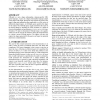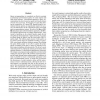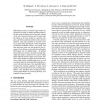147 search results - page 8 / 30 » Reverse Engineering Using Graph Queries |
CGF
2008
13 years 11 months ago
2008
We present a reverse engineering method for constructing a surface approximation scheme whose input is a set of unorganized noisy points in space and whose output is a set of quad...
PVLDB
2010
13 years 9 months ago
2010
XMorph is a new, shape polymorphic, domain-specific XML query language. A query in a shape polymorphic language adapts to the shape of the input, freeing the user from having to k...
WSE
2003
IEEE
14 years 4 months ago
2003
IEEE
Reverse engineering techniques have the potential to support Web site understanding, by providing views that show the organization of a site and its navigational structure. Howeve...
AAAI
2008
14 years 1 months ago
2008
Query recommendation is considered an effective assistant in enhancing keyword based queries in search engines and Web search software. Conventional approach to query recommendati...
VLDB
2000
ACM
14 years 2 months ago
2000
ACM
Maintaining currency of search engine indices by exhaustive crawling is rapidly becoming impossible due to the increasing size and dynamic content of the web. Focused crawlers aim...



